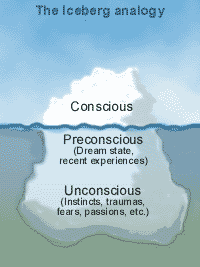Sigmund Freud was the founder of psychoanalysis, or a method of treating mental illness. He spent much of his life studying the brain and how it reacts to emotions. The case of Anna O was one such example of his feats in psychology. Anna was a patient of Dr. Josef Breuer, who suffered from bouts of hysteria. After consulting with Breuer, Freud developed a theory that physical symptoms were just a manifestation of repressed conflicts in the sick person's mind. This resulted in his idea that there are three levels of the mind.
Freud created a model of the mind's three levels using the analogy of an iceberg, where only the tip is showing above the water, but the majority lies hidden under the water. His theory was that the surface is our conscious, which holds thoughts that are the focus of our attention now. The preconscious is the region in which our recent memories are stored. The third area is the unconscious where we process the thoughts that are the real cause of our behavior. Freud thought that if there were traumatic or unpleasant experiences in a person's life, they would repress these memories to the unconscious mind. This spurned the main goal of psychoanalysis, which is to make the unconscious mind conscious.
Freud went on to create another, more detailed model that was comprised of three other entities called ego, super-ego, and id. These were just hypothetical representations for actual mental functions. Freud stated that id was made up of two different instincts ingrained into the unconscious mind. These instincts were Eros and Thanatos. Eros is the instinct of life, or self-preservation, which helps us make decisions to keep ourselves alive. However, Thanatos is the death instinct, which is the aggressive or violent part of the mind. The next entity, ego, is derived from the id so that a person can meet the demands of the id in a socially acceptable way. Lastly, the super-ego is responsible for the moral standard a person holds themselves to. It also helps the ego in acting in a safe and respectable manner. Although these entities are meant to work in tandem, they make demands to each other that cannot be met, which leads to the inner turmoil of the person's mind.


No comments:
Post a Comment
Note: Only a member of this blog may post a comment.